

Neandertals had the capacity to perceive and produce human speech. Neandertals—the closest ancestor to modern humans—possessed the ability to perceive and produce human speech, according to a new study published by an international multidisciplinary team of researchers including Binghamton University anthropology professor Rolf Quam and graduate student Alex Velez.

"This is one of the most important studies I have been involved in during my career", says Quam. "The results are solid and clearly show the Neandertals had the capacity to perceive and produce human speech. Native Americans Inherited Lip Shape Gene from Denisovans. Ancient Teeth Of Possible Neanderthal-Human "Hybrid Population" Discovered In Jersey. Two sets of Neanderthal teeth found in Jersey show some distinctly human characteristics, hinting that these two individuals may have been part of a “hybrid population” produced from interbreeding between Neanderthals and modern humans.

The 13 Neanderthal teeth were originally discovered in the early 20th century at the site of La Cotte de St Brelade in Jersey, a small British island found off the north coast of France. Could Neanderthals Speak? The Ongoing Debate Over Neanderthal Language. Did Neanderthals have language?
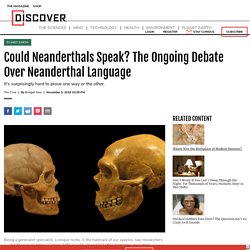
Before trying to answer that, I should admit my bias: I’m team Neanderthal. NPR Choice page. Access Denied. Access Denied. Neanderthals were artists and thought symbolically, new studies argue. Hominins have lived in Western Spain’s Maltravieso Cave off and on for the last 180,000 years.
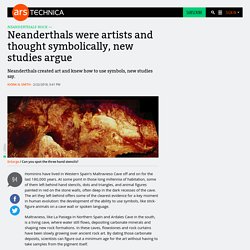
At some point in those long millennia of habitation, some of them left behind hand stencils, dots and triangles, and animal figures painted in red on the stone walls, often deep in the dark recesses of the cave. The art they left behind offers some of the clearest evidence for a key moment in human evolution: the development of the ability to use symbols, like stick-figure animals on a cave wall or spoken language. Ancient Girl Had Denisovan and Neandertal Parents. There has been a ton of great discoveries (see You Might Also Like below) this summer that enhance our understanding of our evolutionary history, including a study recently released in Nature confirming that two groups of our evolutionary cousins – Neanderthals and Denisovans – likely interbred more frequently than was previously known.
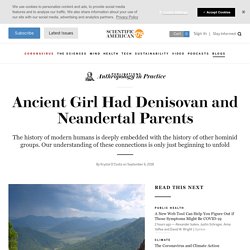
The implications of this study have a direct bearing on us: modern humans carry genetic traces of both Neanderthal and Denisovan DNA and unraveling this complicated genetic heritage may allow us to better understand the social landscape of our evolutionary ancestors. Everything we know about the Denisovans comes from a small body of evidence consisting of a partial finger bone, two teeth, and a single toe recovered from the Denisova Cave in the Altai Mountains in Siberia. Who were the Neanderthals? We know more facts about Neanderthals than any other extinct humans.
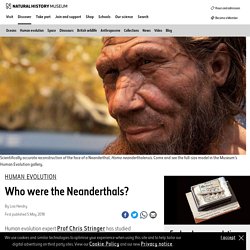
Many thousands of their artefacts and fossils have been found, including several nearly complete skeletons. We also know about their genetic make-up, as several Neanderthal genomes have now been reconstructed from ancient DNA obtained from their fossils. Our closest ancient human relatives Neanderthals were humans like us, but they were a distinct species called Homo neanderthalensis. Read Chris Stringer's argument for why Neanderthals should be considered a separate species from Homo sapiens > Could Neanderthals Create Art? I’m scuttling through a shadowy fairyland of stalactites and stalagmites deep within a cave in southern Spain, an experience as daunting as it is exhilarating.
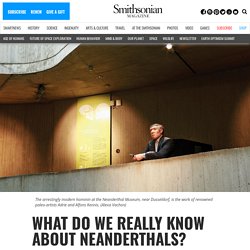
Cueva de Ardales is cool, musty and slightly damp, a contrast to the midsummer sun blazing outside. Garbled voices echo in the distance and beams of headlamps flash nervously in the dark, throwing spooky silhouettes on the limestone. In the flickering half-light I listen to water trickling along a runnel cut into the stone floor and search for the ancient markings that remain tucked beneath layers of calcium carbonate like pentimenti in an old painting. A 50,000-year-old piece of string hints at Neanderthal intelligence, scientists say. What may be the world’s oldest piece of string, made by Neanderthal humans from bark about 50,000 years ago, has been unearthed in a rock shelter in France.

It’s a tiny fragment — just over two-tenths of an inch long — but its discoverers say it shows Neanderthals had extensive knowledge of the trees it was made from, and enough practical ability to make a string that would hold fast under tension. Analysis of the discovery was first released Thursday in the science journal Scientific Reports. It’s the first time that a string or a cord attributed to Neanderthals has been found – and it suggests they used other ancient technologies that have since rotted away, from basketry to clothing to fishing gear. It also suggests that Neanderthals – the archetypal crude cavemen – were smarter than some people give them credit for.
Let our news meet your inbox. The tool from France was a sharp-edged flint used for cutting, and the string could have tied it to a handle, Hardy said. Tom Metcalfe. Hominin species - Were Neanderthals More Than Cousins to H. sapiens? Around 200,000 years ago, in what is now northern Israel, a small band of tech-savvy humans dragged home and dismembered a bounty of wildlife.

Using exquisitely pointed flint spearheads and blades, they hunted and butchered myriad prey, including gazelles, deer, and now-extinct aurochs, the ancestors of modern cattle. In the cool, humid climate of the coastal plain, these early Homo sapiens foraged for acorns in nearby forests of oak, olive, and pistachio. They ate the saline leaves of shrubby saltbush and lugged ostrich eggs back to the cave, where they slurped down the yolks. This vision of the past comes from Haifa University archaeologist Mina Weinstein-Evron. Recent discoveries fundamentally change our picture of human evolution - Business Insider. As anthropologists have discovered new species of human ancestors, our understanding of human history has changed.

By sequencing the genomes from our Neanderthal and Denisovan cousins, scientists have also gained new insight into the genetic origins of our species. As researchers make more of these breakthroughs, the puzzle of who we are and where we came from gets more complicated.The earliest humans may have emerged much earlier, and in a different place in the world, than scientists previously thought.Visit Business Insider's homepage for more stories. In recent years, anthropologists around the world have discovered new human ancestors, figured out what happened to the Neanderthals, and pushed back the age of the earliest member of our species. Taken together, these breakthroughs suggest that many of our previous ideas about the human origin story — who we are and where we came from — were wrong. Found: A Windfall of Neanderthal Footprints in France. Of the variety of ancient hominins who have roamed this planet, Neanderthals are among the most recently departed.
Long stigmatized as lumbering, backwards versions of us—think “caveman” and all that implies—scholarship is increasingly overwriting this view. Face of the Denisovans? Portrait of a Teen Revealed by Her DNA. Based on ancient DNA methylation patterns, a portrait of a juvenile female Denisovan has been recreated. Only two weeks ago I wrote a news piece for Ancient Origins in which I listed all of the known Denisovan remains, which amounted to a finger bone, a few teeth, and a lower jawbone. Nevertheless, from these scanty remains a team of researchers reporting in the journal Cell have produced reconstructions of these long-lost human relatives based on patterns of methylation extracted from ancient DNA. Studying Rare Denisovan DNA. Oldest Neanderthal DNA Found in Italian Skeleton. The calcite-encrusted skeleton of an ancient human, still embedded in rock deep inside a cave in Italy, has yielded the oldest Neanderthal DNA ever found.
These molecules, which could be up to 170,000 years old, could one day help yield the most complete picture yet of Neanderthal life, researchers say. Although modern humans are the only remaining human lineage, many others once lived on Earth. The Denisovans: New Finds are Illuminating the Mysterious Ancient Humans - The Crux. Nestled in foothills of Russia’s Altai Mountains, Denisova Cave has been a research mecca since 2010, when fossil DNA from the site revealed a previously unknown human lineage, now called the Denisovans.
Scientists have been working hard to reconstruct the cave’s history, through ongoing excavations as well as new analyses of materials recovered years ago. Humans Interbred with Four Extinct Hominin Species, Research Finds. As anatomically modern Homo sapiens migrated out of Africa and around the rest of the world, they met and interbred with at least four different hominin species, according to new research from the University of Adelaide, Australia. Neanderthals glued their tools together. Humans and Neanderthals Evolved from a Mystery Common Ancestor, Huge Analysis Suggests. The Teeth of Early Neanderthals May Indicate the Species' Lineage Is Older Than Thought. Neanderthals and modern humans diverged at least 800,000 years ago. (1) 6. Hunting with Neanderthals - OUT OF THE CRADLE [人類誕生CG] / NHK Documentary.
The Hominins We’ve Been Calling Denisovans Are More Diverse Than Previously Thought. Neanderthals and Denisovans Shared a Siberian Cave for Thousands of Years, New Research Suggests. Neanderthal Dental Plaque Shows What a Paleo Diet Really Looks Like. “When people talk about the Paleo diet, that’s not paleo, that’s just non-carb,” Weyrich says.
“The true paleo diet is eating whatever’s out there in the environment.” One of the El Sidron Neanderthals even seemed to be self-medicating with edible plants. NPR Choice page. Cave girl was half Neanderthal, half Denisovan. Engraved Crimean flint could point to Neanderthal symbolism. The evolutionary advantage of having eyebrows. Neanderthals cared for each other and survived into old age – new research. We have more Neanderthal genes than we thought click 2x. Denisovans got lucky other ancients click 2x. Homo neanderthalensis. Neanderthals (the ‘th’ pronounced as ‘t’) are our closest extinct human relative. Some defining features of their skulls include the large middle part of the face, angled cheek bones, and a huge nose for humidifying and warming cold, dry air.
Their bodies were shorter and stockier than ours, another adaptation to living in cold environments. But their brains were just as large as ours and often larger - proportional to their brawnier bodies. Neanderthals were artistic like modern humans, study indicates. The first Britons were black, Natural History Museum DNA study reveals. Humans didn’t outsmart the Neanderthals. We just outlasted them. Genes for Skin Color Rebut Dated Notions of Race, Researchers Say - The New York Times. Neanderthals 101. As much as 2.6% of your DNA is from Neanderthals. This is what its doing.
Neanderthals were distilling tar 200 thousand years ago in Europe. Toothache? Neanderthals Might Have Reached for Aspirin, Too. Neanderthal Teeth From Spain And Belgium Reveal What They Ate And Who They Kissed. In a Lost Baby Tooth, Scientists Find Ancient Denisovan DNA - The New York Times. Ancient humans may have been mothers to some Neanderthals earlier than we thought - The Verge. Ancient skulls may belong to elusive humans called Denisovans. Jersey was a must-see tourist destination for Neanderthals for over 100,000 years. Were Neanderthals Religious? 2x. A Cave in France Changes What We Thought We Knew About Neanderthals. Neanderthals Built Mystery Cave Rings 175,000 Years Ago. Ancient DNA Sequencing Sheds Light on Ice Age European Population History. Oldest ever human genome sequence may rewrite human history. Neanderthals were not inferior to modern humans, says CU-Boulder study. Humans Interbred With Hominins on Multiple Occasions, Study Finds.
Did Neanderthals eat their vegetables? Neanderthal genome shows evidence of early human interbreeding, inbreeding. Neanderthals vs Humans?: German Scientists Bring Fossils into the Computer Age. Neanderthals. QI: some quite interesting facts about Neanderthals. In a Tooth, DNA From Some Very Old Cousins, the Denisovans. Interbreeding: Neanderthals and modern humans mated 50,000 years before we thought. Human evolution: Kissing cousins. Ancestral Lines. Nova - Decoding Neanderthals (PBS Documentary) Research finds Neanderthals were more thoughtful than we once imagined. DNA research confirms recent interaction between Neanderthals and humans. Neanderthals speech similar to humans - per DNA evidence. Humans Did Not Wipe Out the Neanderthals, New Research Suggests.
New evidence on Neanderthal mixing. Rethinking Neanderthals. Oldest Cave Paintings May Be Creations of Neandertals, Not Modern Humans. Neanderthals not as portrayed in fiction-per science. Neanderthals Cooked Their Veggies: Dental Plaque Reveals Eating Habits. Neanderthal. Neanderthals Talked. Evidence varies when Neanderthals died out.
Much Earlier Split for Neanderthals, Humans? Skulls with mix of Neandertal and primitive traits illuminate human evolution. Want a Selfie With a Neanderthal? Visit Europe’s Cave-Man Museums.